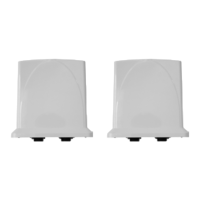Tsunami QB-8100 Series (100 Mbps/5 Mbps Models) Installation and Management Guide 94
If QoS is not configured properly, the system can become difficult to access in heavily loaded networks. One of the side effects
of this misconfiguration is ping time-out, which is usually interpreted as a disconnection of the pinged node. However, with
the correct QoS configuration, every node in the network can be reached at any moment.
The following configuration instructions explain how to configure the system so that configuration parameters can always be
changed, and ping requests and responses get higher priority in order to show the actual connectivity of the pinged node.
The configuration suggested here assumes that the whole network is managed from a single work station, called the
management station. This station can be connected anywhere in the network, and can be recognized by either its IP address,
or by its MAC Ethernet address if the network uses DHCP.
In this configuration, any traffic coming from or going to the management station is treated as management traffic.
Therefore, the management station should be used only for configuration of the Quick Bridge nodes in the network and to
check connectivity of the nodes, but it should not be used for any throughput measurements.
CAUTION: While this QoS configuration is used, the TCP or UDP throughput should not be measured from the
management station.
Step 1: Add Packet Identification Rules
To recognize management traffic, the system needs to recognize ARP requests/responses and any traffic coming from or
going to the management station.
A. Confirm the Attributes of the Existing ARP PIR
The default QoS configuration contains the PIR called “ARP,” which recognizes ARP requests/responses by the protocol
number 0x0806 in the Ethernet Type field of the Ethernet packet. Confirm that the ARP PIR parameters are correct, as
follows:
1. Click ADVANCED CONFIGURATION > QoS > PIR list.
2. Click the Details button corresponding to the ARP PIR.
3. Confirm the following attributes:
• Rule Name: ARP
• Status: Enable
• Enable Ether Type Rule: Yes (checkbox is selected)
— Ether Type: DIX-Snap
— Ether Value: 08:06(hex)
B. Create New PIRs to Recognize Management Traffic
To recognize the traffic coming from or going to the management station, the system must contain two additional PIRs: one
with either the destination IP address or the destination MAC address equal to the management station’s IP or MAC address,
and another with either the source IP address or the source MAC address equal to the management station’s IP or MAC
address. The following examples explain PIR rules based on the IP Address of the Management Station.
1. Click ADVANCED CONFIGURATION > QoS > PIR list > IP Address Entries.
2. Click Add. The screen for adding the Management Station's IP Address appears. Enter proper IP Address, Subnet
mask as 255.255.255.255, Entry status as Enable and then click Add. This adds the Management Station’s IP details
in the IP Address Entries of the PIR List.
3. Click ADVANCED CONFIGURATION > QoS > PIR list.
4. Add PIR Rule for Source IP Address.
a. Click Add. The screen for adding the New PIR Rule appears. Enter the PIR Rule Name as “Management Station
SRC IP”, Entry status as Enable and click Add. This adds the new PIR rule in the PIR List. By default, no
classification rules are applied.
b. Click ADVANCED CONFIGURATION > QoS > PIR list. Click Details for “Management Station SRC IP” PIR rule.
This displays all the classification rule details for this particular rule.

